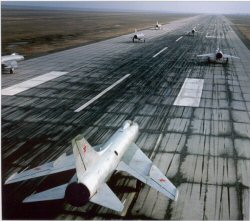
Sukhoi Su-7/-17/-20/-22 Book Review
By Michael Benolkin
| Date of Review | January 2005 | Title | Sukhoi Su-7/-17/-20/-22 |
|---|---|---|---|
| Author | Yefim Gordon | Publisher | Aerofax |
| Published | 2004 | ISBN | 1-85780-108-3 |
| Format | 176 pages, softbound | MSRP (CDN) | $36.95 |
Review
 |
 |
 |
What do you get when you put wings and an engine on a chimney stack? You get an early Sukhoi fighter! With swept wings, it was the Su-7 supersonic fighter-bomber, and with delta wings, it was the Su-9 interceptor.
Yefim Gordon continues his excellent expose of the various aircraft designs that were previously hidden behind the "Iron Curtain". In this installment, he starts with the re-instated Sukhoi OKB's charter to design a supersonic fighter-bomber and interceptor. As the analogy above accurately describes, both aircraft shared a similar fuselage and engine combination, with the differences being in the wings, nose and avionics.
The Su-7 entered service in 1959 and would become one of the principal air-to-ground weapons delivery platforms in the Soviet Air Force. In fact, the Su-7 was widely exported around the Warsaw Pact and allied nations around the world.
Despite becoming the first dedicated supersonic ground attack aircraft, the Soviets soon realized from experience that their supersonic aircraft were lacking in shorter runway/unimproved runway performance due to the high take-off and landing speeds required to fly the aircraft. An improvement program was undertaken by Sukhoi which led to the adoption of fixed inner wing panels with weapons stations and variable geometry (movable) outer wing panels that could be swept forward for slower take-off and landing speeds and swept aft to attain lower drag supersonic flight.
This title by Yefim Gordon walks the reader through the development process in great detail, discussing each of the major models and subvariants of the Fitter family from prototype to the final Su-22M-4 series. The book goes into great detail on avionics fit, weapons carriage and unique features for each of the aircraft. The title contains a good mix of color and black & white photographs from a variety of dates and sources to illustrate the story.
The book continues with a look into the operational history of the aircraft, complete with Soviet combat experiences from Afghanistan and operations within many of the air arms around the world that have (and continue to fly) the Fitter. The title is rounded out with a nice selection of color profiles illustrating the various color and camouflage schemes that have been or are currently carried by Fitters around the world.
This is an excellent title to add to your collection, especially if you follow Soviet aviation.







